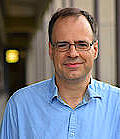Z02: Quantum simulation methods for cooperative effects in strongly correlated light-matter systems

Summary
The cross-sectional scientific service project Z02 provides new tools for the investigation and simulation of correlated emitters. These are, on the one hand, modern neural network state algorithms for classical computers and, on the other hand, tools to be used with quantum computers. Existing approaches are extended and applied to candidate systems from the TRR and access to the requisite hardware is being provided.
Project Leaders
Michael J. Hartmann
Project leader Z02
91058 Erlangen
Friedrich-Alexander-Universität Erlangen-Nürnberg
91058 Erlangen
- Phone number: +49 9131 85-28461
- Email: michael.j.hartmann@fau.de
Frank Wilhelm-Mauch
Project leader Z02
66123 Saarbrücken
Universität des Saarlandes
66123 Saarbrücken
- Phone number: +496813023960
- Email: fwm@lusi.uni-sb.de
Publications
No publications found.


